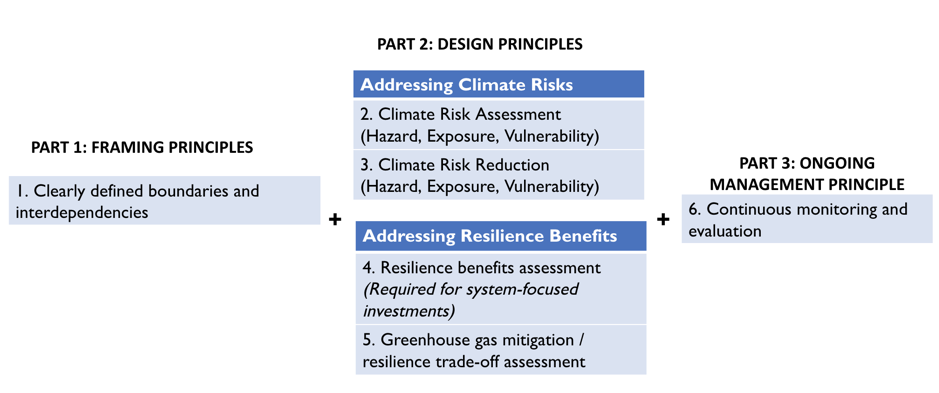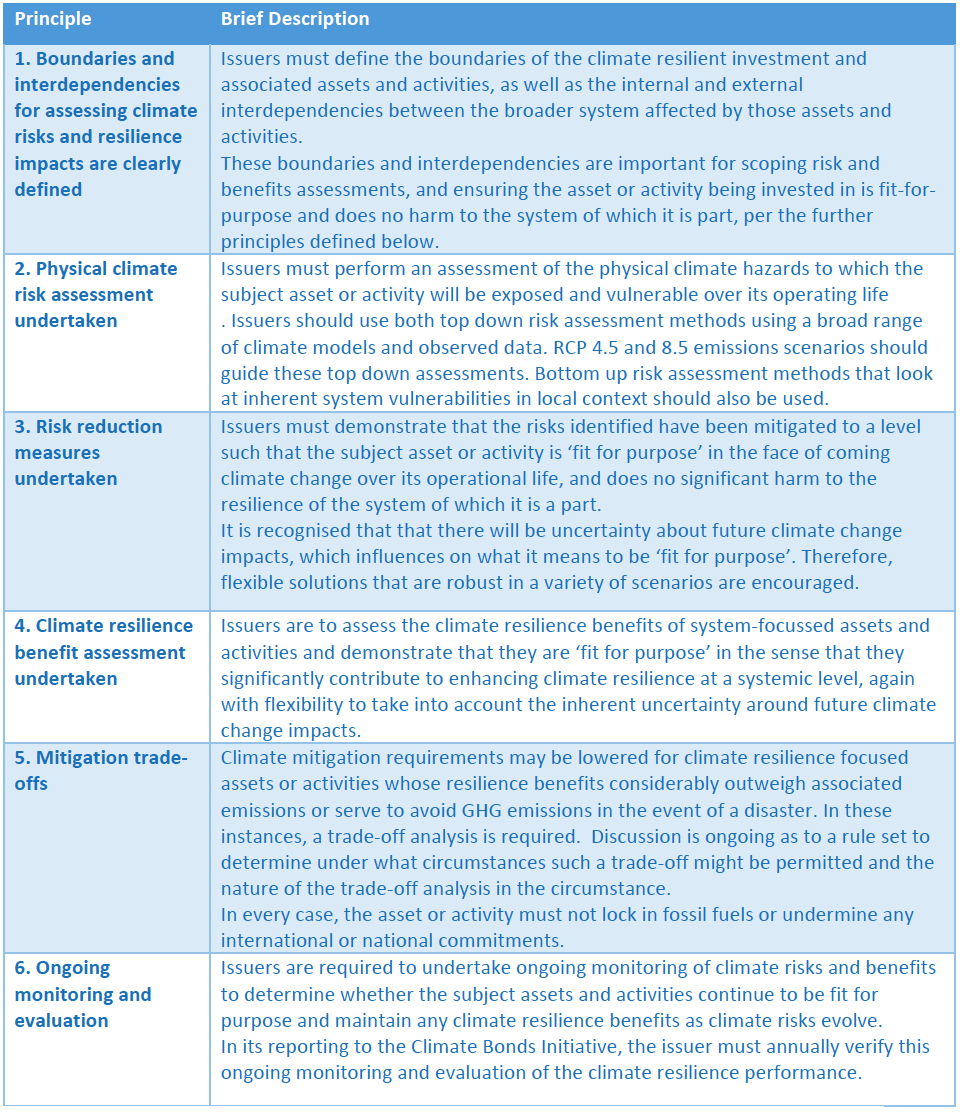Guidance for governments, investors & banks to determine when projects & assets are compatible with a climate resilient economy
Framework for accelerating climate resilient investments in green bond markets

Climate Week NYC - US market launch
New Climate Resilience Principles (CRP) were presented today at the Global Adaptation & Resilience Investment Working Group (GARI) event during Climate Week NYC.
CRP provide a high-level guidance for governments, investors and banks to determine when projects and assets are compatible with a climate resilient economy. This major development programme was set in motion by an Adaptation and Resilience Expert Group convened by Climate Bonds in November 2018.
The Climate Resilience Principles were developed as a partnership between the Climate Bonds Initiative, the World Resources Institute (WRI) and Climate Resilience Consulting using an Adaptation and Resilience Expert Group (AREG), comprised of more than 30 specialists from leading international authorities in the adaptation and resilience space.
The Principles essentially require measures to be taken (in asset or project design, construction or adaptation) that ensure the asset or project is 'fit for purpose' in the face of a changing climate. They are the following, (see Table 1 below for details):
- Boundaries and interdependencies for assessing climate risks and resilience impacts are clearly defined
- Physical climate risk assessment undertaken - using both top down risk assessment and observed data.
- Risk reduction measuresundertaken– commensurate with coming climate change and operational life
- Climate resilience benefit assessment undertaken
- Mitigation trade-offs- the asset or activity must not lock in fossil fuels or undermine any international or national commitments.
- Ongoing monitoring and evaluation as risks evolve
The Principles come at a time when adapting to climate risks opens new opportunities, in both developed and emerging economies, in areas including heat-resilient building materials, water-efficient technology (embracing drip irrigation) and early warning systems for climate hazards, among many others.
EBRD issues first Climate Resilience Bond
The CRP already have started to facilitate climate resilience issuance. Last week the world’s first ever Climate Resilience Bond (USD700m) was successfully brought to market by European Bank for Reconstruction and Development (EBRD).
Environmental Finance reports a coupon of 1.625%, with the bond issued at 99.466% for a yield of 1.737% – 9.2 basis points over the five-year Treasury. Goldman Sachs, BNP Paribas and SEB were joint bookrunners on the transaction, which saw demand from approximately 40 investors in 15 countries.
The ERBD statement advises proceeds from the four-year bond will be used to finance the Bank’s existing and new climate resilience projects. These will typically fall under one of three categories:
- Climate resilient infrastructure (e.g. water, energy, transport, communications and urban infrastructure)
- Climate-resilient business and commercial operations; or
- Climate-resilient agriculture and ecological systems.
The projects earmarked for the Use of Proceeds are selected and managed in alignment with the Climate Resilience Principles.
More information can be found on the EBRD green bond information page.
The CRP Framework
The CRP are divided into three parts, illustrated in Figure 1 and briefly summarised in Table 1:
Part I: Framing principles: This addresses the key preliminary aspects that need to be considered as they inform the risk and benefit assessments undertaken in Part 2. Namely, determining the asset’s or project’s boundary and interdependencies with the systems of which it is a part.
Part II: Design principles: These address the climate risk assessment needed to be undertaken in order to design and implement investments that appropriately address those risks. This includes understanding physical climate hazard, exposure and vulnerability, and potential trade-offs between climate resilience and climate mitigation impacts. For investments focused on enhancing the resilience of the system, this also includes a resilience benefits assessment.
Part III: On-going management principle: This addresses the need for ongoing monitoring and evaluation to ensure resilience actions remain in step with evolving climate hazards, exposure and vulnerability, and changing opportunities and needs for resilience benefits.
Figure 1: Overview of the Climate Resilience Principles

Table 1: The Climate Resilience Principles

Who’s saying what:
Sean Kidney, CEO, Climate Bonds Initiative:
 “Climate change is accelerating; the US is already experiencing crazy fires, hurricanes and floods, extreme because of the impact of climate change. While we work hard to reduce emissions to avoid catastrophic consequences, we now also have to address the challenge of what will be, unfortunately, a century of extreme climate volatility and rising sea levels.”
“Climate change is accelerating; the US is already experiencing crazy fires, hurricanes and floods, extreme because of the impact of climate change. While we work hard to reduce emissions to avoid catastrophic consequences, we now also have to address the challenge of what will be, unfortunately, a century of extreme climate volatility and rising sea levels.”
The Last Word
The CRP will allow for a large uptake of new resilience-based investments.
All the recommendations within the Climate Resilience Principles are aligned with the proposals on adaptation in the EU Taxonomy of Sustainable Finance.
Climate Bonds Initiative will now reconvene sector-specific Technical Working Groups who will use the Principles to develop sector-specific Criteria so that green bonds delivering climate resilience can be recognised and Certified under the Climate Bonds Standard.
In summary, the CRP represent a new stage to increasingly align investment towards the climate impacted world to come.
‘Till next time
Climate Bonds
Find out more on our CRP Page.
Download the Climate Resilience Principles.

